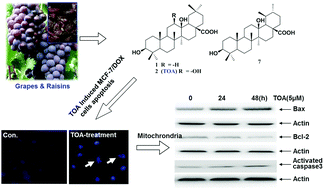Novel triterpenoids isolated from raisins exert potent antiproliferative activities by targeting mitochondrial and Ras/Raf/ERK signaling in human breast cancer cells
Abstract
Raisins are produced in many regions of the world and may be eaten raw or used in cooking, baking and brewing. Bioactivity-guided fractionation of raisins was used to determine the chemical identity of bioactive constituents. Seven triterpenoids, including three novel triterpenoids, were isolated and identified. The novel triterpenoids were elucidated to be 3β,13β-dihydroxy-12,13-dihydrooleanolic acid (1), 3β,12β,13β-trihydroxy-12,13-dihydrooleanolic acid (2, TOA), and 3β,13β-dihydroxy-12,13-dihydroursolic acid (7), respectively. TOA showed the highest antiproliferative activity against MCF-7/DOX cells, with an EC50 value of 3.60 ± 0.55 μM. Compounds 1, 3 and 7 also exhibited potent antiproliferative activity against MCF-7/DOX cells, with an EC50 value of 7.10 ± 0.65, 10.22 ± 0.90 and 8.91 ± 1.12 μM. Compounds 1 and 2 also exhibited potent antioxidant activities. Moreover, the detailed cytotoxic mechanisms of TOA were investigated by targeting the mitochondrial and protein tyrosine kinase signaling (Ras/Raf/ERK). The results strongly demonstrated that the novel triterpenoids isolated from raisins could be promising candidates for therapy of breast cancer.


 Please wait while we load your content...
Please wait while we load your content...